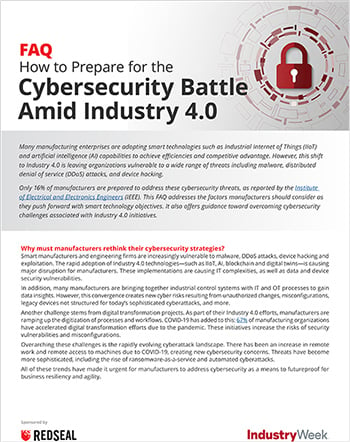Industry 4.0 brings a new set of cybersecurity challenges to the manufacturing industry. Adopting enabling ICS (Industrial Control Systems) technologies like the Industrial Internet of Things (IIoT), Artificial Intelligence (AI) and Smart Factories, all while migrating to the cloud, has increased complexity and expanded the threat landscape, increasing vulnerability exposure.
Manufacturing companies dealing with the convergence of IT and OT are finding it is no easy task. Cyber threats they face in this environment include lack of visibility, inventory gaps and understanding of all devices on their network – whether they are on premises or in the cloud.
Knowing what’s really on your network, what’s connected and what’s at risk allows you to proactively act to mitigate your risk. RedSeal can help.

Ensure your critical resources aren’t exposed to the Internet
See your entire network in one comprehensive, dynamic visualization
Validate your network inventory is accurate and securely configured
Prioritize vulnerabilities based on network location and access


There's no single cause for the explosion of cyber attacks. However, the combination of always-on connected devices with growing cloud computing use and the increasing need for big data analysis in production planning and management all play a role in the evolution of manufacturing attacks.
Here's a look at the underlying causes, possible impacts, and potential remedies.

Many manufacturing enterprises are adopting smart technologies such as Industrial Internet of Things (IIoT) and Artificial Intelligence (AI) capabilities to achieve efficiencies and competitive advantage. However, this shift to Industry 4.0 is leaving organizations vulnerable to a wide range of threats including malware, distributed denial of service (DDoS) attacks, and device hacking.
Only 16% of manufacturers are prepared to address these cybersecurity threats, as reported by the Institute of Electrical and Electronics Engineers (IEEE). We partnered with Industry Week to create this FAQ that addresses the factors manufacturers should consider as they push forward with smart technology objectives. It also offers guidance toward overcoming cybersecurity challenges associated with Industry 4.0 initiatives.